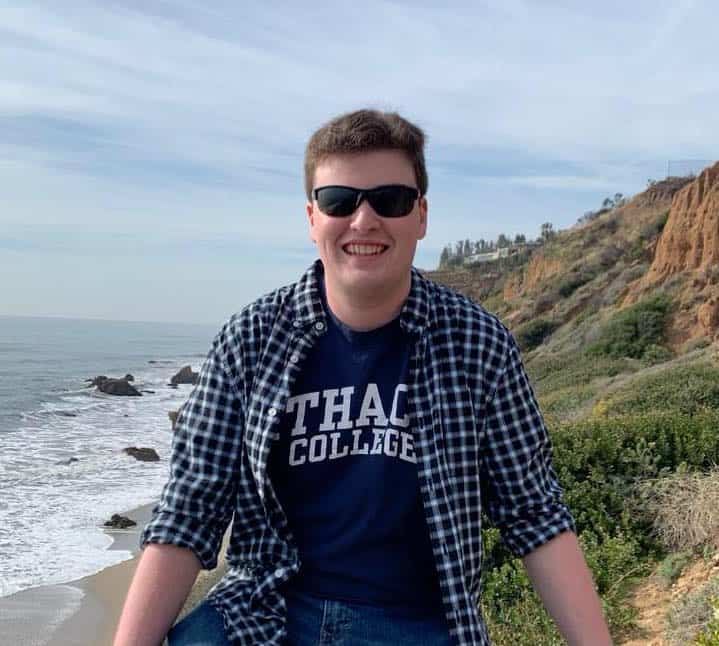Often hailed as one of the most innovative and influential acts of the 1960s, The Doors’ unique blend of rock ‘n’ roll, jazz, blues, psychedelia, and mysticism cemented them as key figures in the counterculture of that era. The band’s most famous lineup was made up of singer/poet Jim Morrison, keyboardist Ray Manzarek, guitarist Robby Krieger, and drummer John Densmore.
Signed to Elektra Records by label head Jac Holzman in 1966, the group recorded six acclaimed studio albums in the span of just five years–1967’s self-titled debut and Strange Days, 1968’s Waiting For The Sun, 1969’s The Soft Parade, 1970’s Morrison Hotel, and 1971’s L.A. Woman–prior to Morrison’s tragic death in July 1971 at the age of 27.
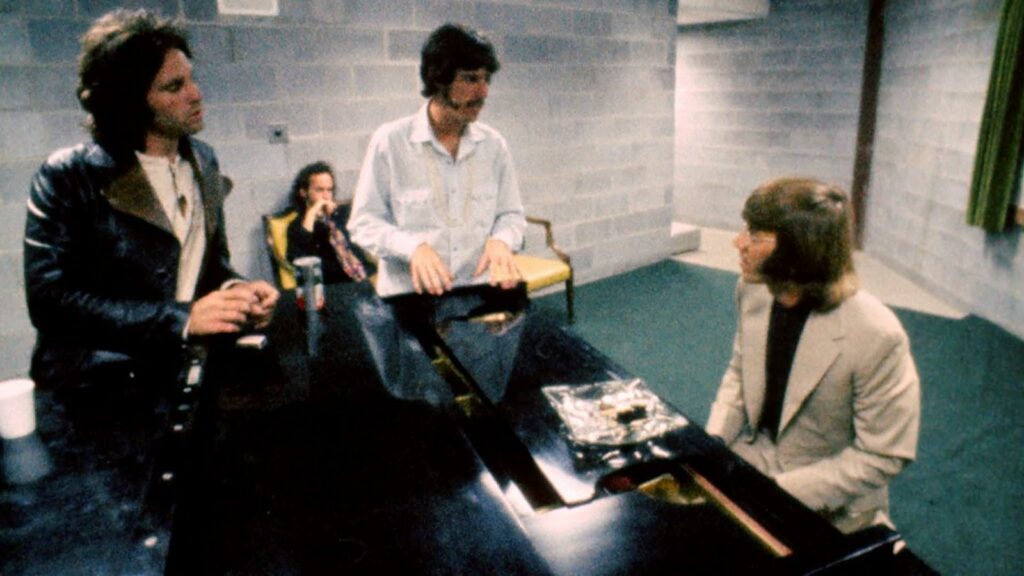
In 1973–just two years after Morrison’s passing–Holzman and Elektra Records began releasing albums in the burgeoning new quadraphonic format that briefly took the music industry by storm. Four-channel vinyl and tape editions of the latest albums by popular Elektra artists such as Carly Simon, Bread, and Judy Collins quickly appeared on store shelves throughout that year.
To celebrate The Doors’ music and create further excitement around the advent of quadraphonic sound, Holzman and engineer Bruce Botnick oversaw new four-channel mixes of eleven songs from across the band’s discography (ten studio tracks plus “Who Do You Love?” from 1970’s Absolutely Live) for a Best Of compilation made available exclusively in the new format.
The Best Of The Doors was released on quadraphonic vinyl (in the ‘CD-4’ format), 8-track cartridge, and reel-to-reel tape in September 1973.

Despite the limitations of recording technology in those years (all the albums from 1967's Strange Days onward were recorded on one-inch, eight-channel magnetic tape), The Doors' music lent itself remarkably well to the new format. These quadraphonic mixes were just as experimental and daring as the source material called for, often placing Densmore’s drum kit and Manzarek’s keyboards directly behind the listener.
Additional layers such as the orchestration in “Touch Me” and thunderstorm sounds in “Riders On The Storm” were also placed in the rear speakers to great effect, while Morrison's voice stayed anchored to the front stage. Even the three songs from the 1967 debut album–which was recorded on four-track tape–included on the compilation (“Soul Kitchen,” “Take It As It Comes,” and “Light My Fire”) manage to fill out the expanded listening space nicely.
Though I imagine The Best Of The Doors was likely intended as a precursor to quadraphonic releases of all the band’s studio albums, those sadly never came to pass as Warner’s support for the format had all but evaporated by 1975. In recent years, the Best Of quadraphonic mix has been reissued twice in digital form: first on Super Audio CD by Audio Fidelity in 2015, then again on Blu-Ray by Warner/Rhino as part of the 2017 three-disc edition of The Singles.
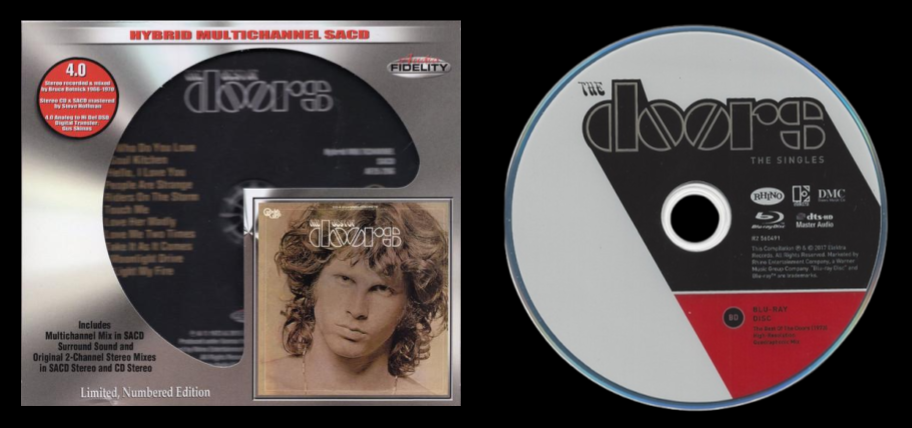
Nearly three decades later, when Warner began commissioning 5.1 surround sound mixes of classic albums, L.A. Woman was selected as one of the very first titles to be reissued in the new high-resolution DVD-Audio format. For the DVD-A, original recording/mix engineer and co-producer Bruce Botnick was brought in to create a 5.1 surround mix of the album using the original eight-track session recordings.
To celebrate the 40th anniversary of the band’s debut record in 2006, Warner/Rhino issued the career-spanning 12-disc Perception box set. The set houses CD and DVD-Audio discs of all six studio albums, with each DVD-A containing Botnick's brand-new 96-khz/24-bit stereo and 5.1 surround sound mixes. These 40th anniversary remixes remain somewhat controversial among fans due to Botnick’s inclusion of elements that were omitted from the originals, such as the extended intro to “L.A. Woman” and studio chatter at the very beginning of "Hello, I Love You."
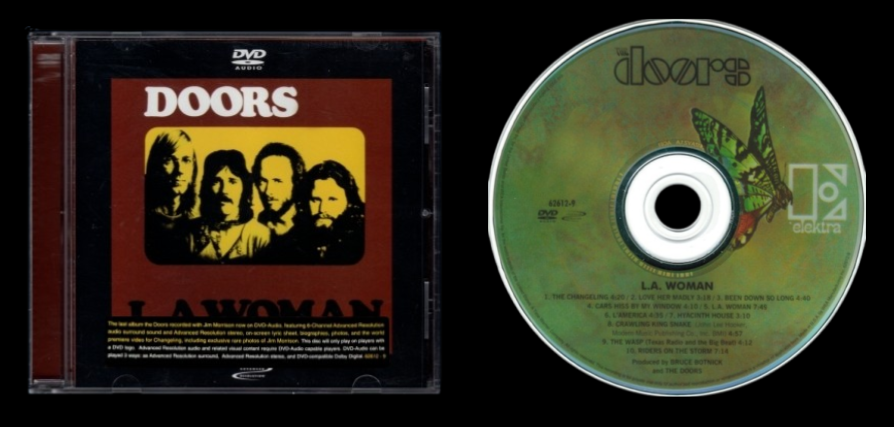
Much like the 1973 quadraphonic Best Of release, the 40th anniversary 5.1 surround mixes are relatively experimental in their deployment of the additional speakers. Morrison’s vocal is almost completely isolated in the center channel, while Manzarek's keyboards usually appear from behind. There are even some fun passages where instruments swirl around the room, like the drum breaks in “Love Her Madly” and marching sound effects in “The Unknown Soldier.”
As one might expect, the last three albums work best in surround sound due to the complexity of the production. The Soft Parade in particular is really effective in 5.1, with the main band elements in front playing nicely off the orchestration in the back channels. The debut album is unfortunately more of a three-channel presentation, with just studio ambience filling out the rear soundstage. While not spectacular by any means, I found the ‘73 quad mixes of "Soul Kitchen,” “Take It As It Comes,” and “Light My Fire,” to be considerably more effective in their usage of the extra space.
Though Perception is long out-of-print and remains a collectors item today, the 40th anniversary stereo and 5.1 surround mixes of all six albums are still available to purchase as separate Super Audio CD editions from noted reissue label Analogue Productions. According to online vendor Acoustic Sounds, the DSD 5.1 program on all six of The Doors’ SACDs is sourced from the original 96-khz/24-bit PCM files mixed and mastered by Bruce Botnick in 2006.
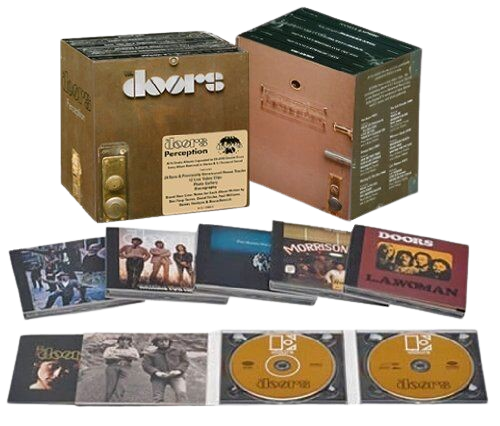
Fast-forward another 15 years and with the advent of immersive streaming, Bruce Botnick has remixed The Doors' catalog once again–this time in Dolby Atmos. Though the full Atmos mixes of all six studio albums unfortunately remain exclusive to streaming services such as Apple Music, Tidal, and Amazon Music, Warner/Rhino have additionally come through with an audio-only Blu-Ray release of The Best Of The Doors (the 1985 double-LP compilation, rather than the aforementioned 1973 11-track album of the same name).
The Blu-Ray disc contains a whopping 19 classic songs, each available in three formats: Dolby Atmos (out on streaming services since 2022, never-before-released in high-resolution on physical media), 5.1 surround sound (previously-released on DVD-Audio in 2006), and traditional two-channel stereo (these are the original stereo mixes, rather than the 40th anniversary remixes created in 2006 alongside the 5.1's for the Perception box set).
Much to my surprise, these new Atmos mixes are considerably different from the 2006 5.1 attempts. Botnick has tinkered with the multitracks some more, introducing previously-unheard segments such as the new extended intro to “Riders On The Storm” that transports you into the control room just before the recording light turns red (when Morrison humorously declares “it’s take ten…it’ll never be take ten again”).
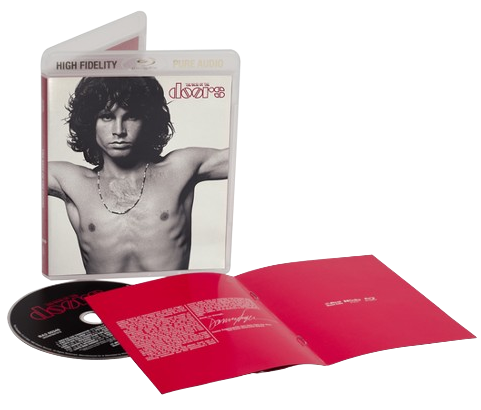
The height speakers are active participants throughout the proceedings, supplying studio ambience as well as key instrumentation like the guitar solo in “People Are Strange,” harmonica in “Roadhouse Blues,” and of course the thunderstorm effects in “Riders On The Storm” (if ever there was a song that justified having extra speakers put in the ceiling!).
The songs from the debut album are again front-centric due to the extremely-limited multitrack recordings, but from Strange Days onward the Atmos mixes become much bolder. For instance, the short guitar solo midway through “People Are Strange" comes entirely from the front height speakers, while the double-tracked vocals at the end emerge from the rear heights. “When The Music’s Over” starts off as more of an ambient presentation, but then Kreiger’s fuzz guitars suddenly appear overhead at around the three-minute mark.
Whereas both the quadraphonic and 5.1 surround sound mixes of "Hello, I Love You" placed the harmony vocals ("holds her head so high...") behind the listener, here they remain pegged to the front left speaker. The sweeping sound just after the one-minute mark does amusingly circle the height array though, along with some 'new' vocals during the coda.

The marching sounds in “The Unknown Soldier” rotate all around the room just like in the prior 5.1 mix, but Morrison’s drill sergeant vocals now come from above. “Waiting For The Sun” is as powerful as ever with Manzarek’s keys now extending from the side surrounds up into the heights, but one fun touch I miss from the 2006 5.1 version is the frenetic swirling guitar solo at around three minutes in (here it’s stationary in the front right speaker). Similarly, the drum breaks in “Love Her Madly” no longer pan between the front and back speakers.
“L.A. Woman” spreads the instrumentation far and wide, with keyboards front left, lead guitar front right, rhythm guitar rear left, and piano rear right. Percussion fills in from the side surrounds, while the height array is used primarily for reverb. Whereas Morrison’s chants of ‘Mr. Mojo Risin’ circled the room in the 5.1 mix to fun-albeit-gimmicky effect, those vocals instead hold a static position in the center channel for the new Atmos mix.
From an immersive standpoint, unsurprisingly "Riders On The Storm" would have to be the standout track on this compilation. The rain and thunder sound effects are given much more prominence, with the rain taking up residence behind the listener in the rear surrounds and the thunder moving through the height array to spine-tingling effect. Towards the end, some never-before-heard Morrison vocals and finger snaps appear from above as well.

Overall, it’s hard to argue with nearly 90 minutes of The Doors’ very best music presented in high-resolution Dolby Atmos, 5.1 surround, and stereo on an inexpensive single-disc reissue. Even for owners of the previous quad or 5.1 releases, the new Atmos mixes present yet another unique way to revisit these iconic recordings. I’d argue “Riders On The Storm” alone is almost worth the price of admission.
It’ll be interesting to see if the full Atmos mixes of all six albums eventually receive physical releases, either as standalone Blu-Rays like this one or part of a larger Perception or Infinite-style box set. Some of the lesser-known album tracks not included on this compilation sound amazing in Atmos, like “My Wild Love” from Waiting For The Sun (the a capella backing vocals are placed up in the height speakers) or “Cars Hiss By My Window” from L.A. Woman (the percussion marches all around the room).
The Best Of The Doors is just one of four brand-new standalone Blu-Ray releases from Warner/Rhino containing high-resolution Dolby Atmos mixes–the other titles being Fleetwood Mac’s Rumours (1977), Hootie & The Blowfish’s Cracked Rear View (1994), and Alanis Morissette’s Jagged Little Pill (1995). If this initial batch of four represents the start of an ongoing series, I’m hopeful that Rhino will see fit to release other great Dolby Atmos titles up on the streaming services such as The Grateful Dead’s American Beauty (1970) and Tom Petty & The Heartbreakers’ Mojo (2010) in this format.
